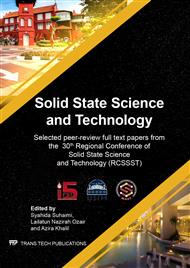p.143
p.149
p.154
p.160
p.166
p.171
p.179
p.185
p.192
Characterization of BCZY Ceramic Material Prepared with Treated Activated Carbon from Empty Fruit Bunches (EFB)
Abstract:
The activated carbon produced from oil palm empty fruit bunches (ACEFB) shows good properties to act as a dispersing agent in the synthesis of BCZY ceramic material. However, the untreated ACEFB (u-ACEFB) shows some impurities still present after calcination. Thus, it has to be functionalized (f-ACEFB) by using chemical treatment. In this work, three samples of bare BCZY, BCZY u-ACEFB and BCZY f-ACEFB were prepared, respectively. The sol-gel method was used to synthesize the BCZY ceramic powder by using metal nitrate salt as a starting material. The ACEFB was added to the metal precursor accordingly and was dried (T=325°C) followed by calcined (T=1100°C). For the fabrication of pellet, the sample was sintered by two-step sintering (TSS) method. The relative density of pellet was measured and calculated. The Fourier Transform Infrared (FTIR) spectroscopy, Scanning Electron Microscopy (SEM) and Energy Dispersive X-ray (EDX) were conducted to characterize the synthesized BCZY ceramic material. Based on the characterization, BCZY u-ACEFB have the highest relative density among the others, whereas BCZY f-ACEFB have the lowest relative density. The FTIR results further confirmed the presence of the functional groups corresponded to the BCZY. The SEM micrograph shows a spherical structure of BCZY f-ACEFB with grain size around 134 nm. EDX data further confirm the elemental composition of the pellet. It was observed that the f-ACEFB have an outstanding performance as a dispersing agent in BCZY synthesizing route.
Info:
Periodical:
Pages:
166-170
Citation:
Online since:
July 2020
Authors:
Keywords:
Price:
Сopyright:
© 2020 Trans Tech Publications Ltd. All Rights Reserved
Share:
Citation:


